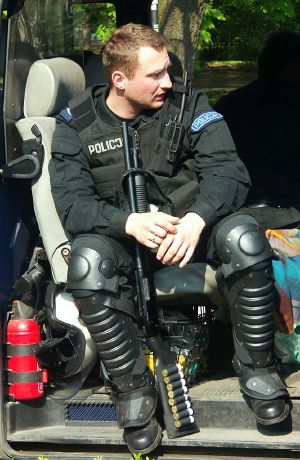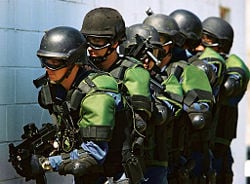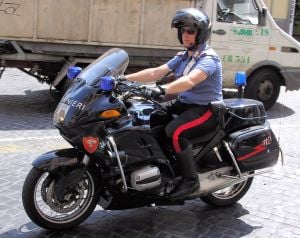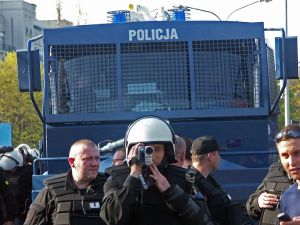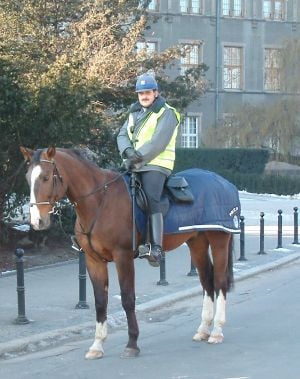
Police or law enforcement agents or agencies are those empowered to use force and other forms of coercion and legal means to effect public and social order. The term is most commonly associated with police departments of a state that are authorized to exercise the police power of that state within a defined legal or territorial area of responsibility.
The responsibilities of police include fighting crime, but more generally consist of all activities that maintain the public welfare. This includes both protecting citizens from those who pose a threat, whether from within the community or outside, and preventing them from acting in disorderly fashion or otherwise in ways that disturb the order of society. Some of these responsibilities overlap with those of the military, but the general mandate of the police is to protect citizens, removing the innocent from harm's way, while the military take a more aggressive responsibility. Law enforcement methods range from the wearing of uniforms and the use of obviously marked vehicles that promote the sense of authority, to investigations of crimes, to undercover operations involving infiltration into suspected criminal groups. In all, though, the task of law enforcement is to maintain a society that operates according to the established norms and laws, for the benefit of all its members.
Etymology
The word police comes from the Latin politia (âcivil administrationâ), which itself derives from the Ancient Greek ÏÏλÎčÏ, for polis ("city").[1] Alternative names for police force include constabulary, gendarmerie, police department, police service, or law enforcement agency, and members can be police officers, constables, troopers, sheriffs, rangers, or peace officers.
History
In ancient times, the military was mostly responsible for maintaining law and order in cities. The Roman Empire had a reasonably effective law enforcement' system until the decline of the empire, though there was never an actual police force in the city of Rome. When under the reign of Augustus the capital had grown to almost one million inhabitants, he created 14 wards, which were protected by seven squads of 1,000 men. If necessary, they might have called the Praetorian Guard for assistance. Beginning in the fifth century, policing became a function of clan chiefs and heads of state.
All civilizations and cultures, from the Babylonians onwards, had a group comparable to the concept of "police." The Anglo-Saxon system was a private system of tithings, since the Norman conquest lead by a constable, which was based on a social obligation for the good conduct of the others; more common was that local lords and nobles were responsible to maintain order in their lands, and often appointed a constable, sometimes unpaid, to enforce the law.
In Western culture, the contemporary concept of a police paid by the government was developed by French legal scholars and practitioners in the seventeenth century and early eighteenth century. As a result of this development of jurisprudence, the first police force in the modern sense was created by the government of King Louis XIV in 1667 to police the city of Paris, then the largest city of Europe and considered the most dangerous. The royal edict, registered by the Parlement of Paris on March 15, 1667 created the office of lieutenant gĂ©nĂ©ral de police ("lieutenant general of police"), who was to be the head of the new Paris police force, and defined police as the task of "ensuring the peace and quiet of the public and of private individuals, purging the city of what may cause disturbances, procuring abundance, and having each and everyone live according to their station and their duties." The lieutenant gĂ©nĂ©ral de police had under his authority 44 commissaires de police ("police commissioners"). The city of Paris was divided into 16 districts policed by the 44 commissaires de police, each assigned to a particular district and assisted in their districts by clerks and a growing bureaucracy. The scheme of the Paris police force was extended to the rest of France by a royal edict of October 1699, resulting in the creation of lieutenant generals of police in all large French cities or towns. These police forces were later assisted by inspecteurs de police (âpolice inspectorsâ), created in 1709.
After the troubles of the French Revolution, the Paris police force was reorganized by Napoléon I on February 17, 1800, as the Prefecture of Police, along with the reorganization of police forces in all French cities with more than 5,000 inhabitants. On March 12, 1829, a government decree created the first uniformed policemen in Paris and all French cities, known as sergents de ville ("city sergeants"), which the Paris Prefecture of Police's website claims were the first uniformed policemen in the world.[2]
In the United Kingdom, the development of police forces was much slower than in the rest of Europe. The word "police" was borrowed from French into the English language in the eighteenth century, but for a long time it applied only to French and continental European police forces. The word and the concept of police were "disliked as a symbol of foreign oppression." Prior to the nineteenth century, the only official use of the word "police" recorded in the United Kingdom was the appointment of Commissioners of Police for Scotland in 1714 and the creation of the Marine Police in 1798 (set up to protect merchandise at the Port of London).
On June 30, 1800, the authorities of Glasgow, Scotland successfully petitioned the government to pass the Glasgow Police Act establishing the City of Glasgow Police. This was the first professional police service in the country that differed from previous law enforcement in that it was a preventive police force. This was quickly followed in other Scottish towns, which set up their own police forces by individual acts of Parliament.[3] In London, there existed watchmen hired to guard the streets at night since 1663, the first paid law enforcement body in the country, augmenting the force of unpaid constables. On September 29, 1829, the Metropolitan Police Act was passed by Parliament, allowing Sir Robert Peel, then Home Secretary, to found the London Metropolitan Police. This group of police is often referred to as âBobbiesâ or âPeelersâ due to their being established by Peel. They were regarded as the most efficient forerunners of a modern police force and became a model for the police forces in most countries, such as the United States. Many of the Commonwealth Countries developed police forces using similar models, such as Australia and New Zealand.
In North America, the Toronto Police was founded in Canada in 1834, one of the first municipal police departments on that continent; followed by police forces in Montréal and Québec City, both founded in 1838. In the United States, the first organized police services were established in Boston in 1838, New York in 1844, and Philadelphia in 1854.
Police Divisions
Most police forces contain subgroups whose job it is to investigate particular types of crime.
In most Western police forces, perhaps the most significant division is between "uniformed" police and detectives. Uniformed police, as the name suggests, wear uniforms and perform functions that require an immediate recognition of an officer's legal authority, such as traffic control, stopping and detaining motorists, and more active crime response and prevention. Detectives, by contrast, wear business attire in bureaucratic and investigative functions where a uniformed presence would be either a distraction or intimidating, but a need to establish police authority still exists. "Plainclothes" officers dress in attire consistent with that worn by the general public for purposes of blending in. In some cases, police are assigned to work "undercover," where they conceal their police identity, sometimes for long periods, to investigate crimes, such as organized crime, unsolvable by other means. This type of policing shares much with espionage.
Specialized groups exist within many law enforcement organizations either for dealing with particular types of crime, such as traffic law enforcement and crash investigation, homicide, or fraud; or for situations requiring specialized skills, such as underwater search, aviation, explosive device disposal ("bomb squad"), and computer crime. Larger jurisdictions also employ specially selected and trained quasi-military units armed with military-grade weapons for the purposes of dealing with particularly violent situations beyond the capability of a patrol officer response, including high-risk warrant service and barricaded suspects. In the United States these units go by a variety of names, but are commonly known as SWAT (Special Weapons and Tactics) teams. Because their situational mandate typically focuses on removing innocent bystanders from dangerous people and dangerous situations, not violent resolution, they are often equipped with non-lethal tactical tools like chemical agents, "flashbang" and concussion grenades, and rubber bullets.
Western law enforcement commonly employs "internal affairs" police whose job is to oversee and investigate the officers themselves. They limit their work to fighting bribery, political corruption, and other forms of internal corruption.
Despite popular conceptions promoted by movies and television, many U.S. police departments prefer not to maintain officers in non-patrol bureaus and divisions beyond a certain period of time, such as in the detective bureau, and instead maintain policies that limit service in such divisions to a specified period of time, after which officers must transfer out or return to patrol duties. This is done in part based upon the perception that the most important and essential police work is accomplished on patrol in which officers become acquainted with their beats, prevent crime by their presence, respond to crimes in progress, manage crises, and practice their skills. Detectives, by contrast, usually investigate crimes after they have occurred and after patrol officers have responded first to a situation. Investigations often take weeks or months to complete, during which time detectives spend much of their time away from the streets, in interviews and courtrooms, for example. Rotating officers also promotes cross-training in a wider variety of skills, and serves to prevent "cliques" that can contribute to corruption or other unethical behavior.
Police armament and equipment
In many jurisdictions, police officers carry firearms, primarily handguns, in the normal course of their duties.
Police often have specialist units for handling armed offenders, and similar dangerous situations, and can (depending on local laws), in some extreme circumstances, call on the military (since Military Aid to the Civil Power is a role of many armed forces). A high-profile example of this was when, in 1980 the Metropolitan Police handed control of the Iranian Embassy Siege to the Special Air Service. They can also be equipped with non-lethal (more accurately known as "less than lethal" or "less-lethal") weaponry, particularly for riot control. Non-lethal weapons include batons, riot control agents, rubber bullets, and electroshock weapons. The use of firearms or deadly force is typically a last resort only to be used when necessary to save human life, although some jurisdictions allow its use against fleeing felons and escaped convicts. Police officers often carry handcuffs to restrain suspects.
Modern police forces make extensive use of radio communications equipment, carried both on the person and installed in vehicles, to coordinate their work, share information, and get help quickly. In recent years, vehicle-installed computers have enhanced the ability of police communications, enabling easier dispatching of calls, criminal background checks on persons of interest to be completed in a matter of seconds, and updating the officer's daily activity log and other required reports on a real-time basis. Other common pieces of police equipment include flashlights, whistles, and, most importantly, notebooks and "ticketbooks" or citations.
Police vehicles
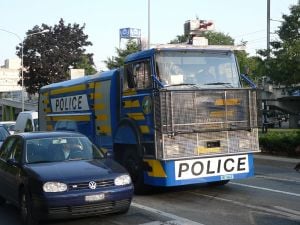
Police vehicles are used for detaining, patrolling, and transporting. The common police patrol vehicle is a four-door sedan (saloon in the UK), much like a normal sedan but with enhancements. Police vehicles are usually marked with appropriate logos and are equipped with sirens and lightbars to aid in making others aware of police presence. Unmarked vehicles are used primarily for apprehending criminals without alerting them to their presence. Some cities and counties have started using unmarked cars, or cars with minimal markings, for traffic law enforcement, since drivers slow down at the sight of marked police vehicles and unmarked vehicles make it easier for officers to catch speeders and traffic violators.
Motorcycles are also commonly used, particularly in locations that a car may not be able to access, or to control potential public order situations involving meetings of motorcyclists. They are often used in escort duties where the motorcycle policeman can quickly clear a path for the escorted vehicle.
Policing strategies
The advent of the police car, two-way radio, and telephone in the early twentieth century transformed policing into a reactive strategy that focused on responding to calls for service.[4] With this transformation, police command and control became more centralized. August Vollmer introduced other reforms, including education requirements for police officers.[5] O. W. Wilson, a student of Vollmer, helped reduce corruption and introduce professionalism in Wichita, Kansas, and later in the Chicago Police Department.[6] Strategies employed by O. W. Wilson included rotating officers from community to community to reduce their vulnerability to corruption, establishing a non-partisan police board to help govern the police force, creating a strict merit system for promotions within the department, and implementing an aggressive, recruiting drive with higher police salaries to attract professionally qualified officers.[7] During the professionalism era of policing, law enforcement agencies concentrated on dealing with felonies and other serious crime, rather than broader focus on crime prevention.[8]
The Kansas City Preventive Patrol Study in the 1970s found this approach to policing to be ineffective. Patrol officers in cars were disconnected from the community, and had insufficient contact and interaction with the community.[9] In the 1980s and 1990s, many law enforcement agencies began to adopt community policing strategies, and others adopted problem-oriented policing. Broken windows policing was another, related approach introduced in the 1980s by James Q. Wilson and George L. Kelling, who suggested that police should pay greater attention to minor "quality of life" offenses and disorderly conduct.[10] Building upon these earlier models, intelligence-led policing has emerged as the dominant philosophy guiding police strategy. Intelligence-led policing and problem-oriented policing are complementary strategies, both which involve systematic use of information.[11] Although it still lacks a universally accepted definition, the crux of intelligence-led policing is an emphasis on the collection and analysis of information to guide police operations, rather than the reverse.[12]
Restrictions on Police Power
In order for police officers to do their job, they may be vested by the state with a monopoly in the use of certain powers. These include the powers to arrest, search, seize, and interrogate; and if necessary, to use lethal force. In nations with democratic systems and the rule of law, the law of criminal procedure has been developed to regulate officers' discretion, so that they do not exercise their vast powers arbitrarily or unjustly.
In U.S. criminal procedure the most famous case is Miranda v. Arizona, which led to the widespread use of Miranda warnings or constitutional warnings. U.S. police are also prohibited from holding criminal suspects for more than a reasonable amount of time (usually 72 hours) before arraignment, using torture to extract confessions, using excessive force to effect an arrest, and searching suspects' bodies or their homes without a warrant obtained upon a showing of probable cause. Using deception for confessions is permitted, but not coercion. There are exceptions or exigent circumstances such as an articulated need to disarm a suspect or searching a suspect who has already been arrested (search incident to an arrest). The Posse Comitatus Act severely restricts the use of the U.S. military for police activity, giving added importance to police SWAT units.
British police officers are governed by similar rules, particularly those introduced under the Police and Criminal Evidence Act 1984, but generally have greater powers. They may, for example, legally search any suspect who has been arrested, or their vehicles, home, or business premises, without a warrant, and may seize anything they find in a search as evidence. All police officers in the United Kingdom, whatever their actual rank, are âconstablesâ in terms of their legal position. This means that a newly appointed constable has the same arrest powers as a chief constable or commissioner. However, certain higher ranks have additional powers to authorize certain aspects of police operations, such as a power to authorize a search of a suspect's house (section 18 PACE) by an officer of the rank of inspector, or the power to authorize a suspect's detention beyond 24 hours by a superintendent.
Police conduct and accountability
Investigation of police corruption is sometimes made more difficult by a code of silence that encourages unquestioning loyalty to comrades over the cause of justice. If an officer breaks this code, they may receive death threats or even be left for dead, as in the case of Frank Serpico. One way to fight such corruption is by having an independent or semi-independent organization investigate, such as (in the United States) the Federal Justice Department, state attorneys general, local district attorneys, a police department's own internal affairs division, or specially appointed commissions. However, independent organizations are generally not used except for the most severe cases of corruption.
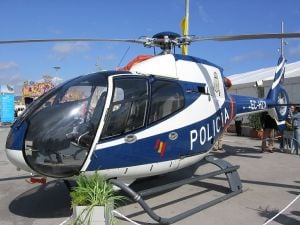
Use of force
Police forces also find themselves under criticism for their use of force, particularly deadly force, when a police officer of one race kills a suspect of another race. In the United States, such events routinely spark protests and accusations of racism against police.
In the United States since the 1960s, concern over such issues has increasingly weighed upon law enforcement agencies, courts, and legislatures at every level of government. Incidents such as the 1965 Watts Riots, the videotaped 1991 beating by Los Angeles police officers of Rodney King, and the riot following their acquittal has depicted American police as dangerously lacking in appropriate controls. The fact that this trend has occurred contemporaneously with the rise of the U.S. civil rights movement, the "War on Drugs," and a precipitous rise in violent crime from the 1960s to the 1990s has made questions surrounding the role, administration, and scope of authority of police specifically and the criminal justice system as a whole increasingly complicated. Police departments and the local governments that oversee them in some jurisdictions have attempted to mitigate some of these issues through community outreach programs and community policing to make the police more accessible to the concerns of local communities; by working to increase hiring diversity; by updating training of police in their responsibilities to the community and under the law; and by increased oversight within the department or by civilian commissions. In cases in which such measures have been lacking or absent, local departments have been compelled by legal action initiated by the U.S. Department of Justice under the 14th Amendment to enter into consent decree settlements to adopt such measures and submit to oversight by the Justice Department.
Some believe that police forces have been responsible for enforcing many bigoted perspectives. Ageism against teens, classism, homophobia, racism, and sexism are views that police have been charged with having held and enforced. Some police organizations are faced with routine accusations of racial profiling.
Recruitment
The social status and pay of police can lead to problems with recruitment and morale. Jurisdictions lacking the resources or the desire to pay police appropriately, lacking a tradition of professional and ethical law enforcement, or lacking adequate oversight of the police often face a dearth of quality recruits, a lack of professionalism and commitment among their police, and broad mistrust of the police among the public. These situations often strongly contribute to police corruption and brutality. This is particularly a problem in countries undergoing social and political development; countries that lack rule of law or civil service traditions; or countries in transition from authoritarian or communist governments in which the prior regime's police served solely to support the ruling government.
Police Worldwide
There exist a number of key differences among police forces worldwide. The first of these is the police force's connection with their country's military. Separation of these forces is one key way of protecting citizens' freedom and democracy. Separation from the prosecution of crimes is equally important. Another difference is the use of weapons. Many countries, notably those in western Europe, do not carry firearms. This raises a debate over the perceived freedom of a people in a state in correlation with the arming of their local police.
In many countries, particularly those with a federal system of government, there may be several police or police-like organizations, each serving different levels of government and enforcing different subsets of the applicable law. The United States has a highly decentralized and fragmented system of law enforcement, with over 17,000 state and local law enforcement agencies.[13] Other countries, such as Chile, Israel, and Austria, use a centralized system of policing.[14] Though the United States and other countries have multiple police forces, for the most part their jurisdictions do not overlap. In some countries, jurisdiction of multiple police agencies overlap, as with Guardia Civil and the PolicĂa Nacional in Spain.[15] Also, most countries are members of the International Criminal Police Organization (Interpol), established to detect and fight transnational crime and provide for international cooperation and coordination of other police activities, such as notifying relatives of the death of foreign nationals. Interpol does not conduct investigations or arrests by itself, but only serves as a central point for information on crime, suspects, and criminals. Political crimes are excluded from its competencies.
Notes
- â Douglas Harper, Police, Online Etymology Dictionary. Retrieved November 12, 2007.
- â Paris Prefecture of Police, Des Sergents de Ville et Gardiens de la Paix Ă la police de proximitĂ©: la PrĂ©fecture de Police au service des citoyens. Retrieved April 9, 2007.
- â Alastair Dinsmor, Glascow Police Pioneers, Scotia News.
- â Albert J. Reiss, Jr., âPolice Organization in the Twentieth Century, Crime and Justice 51 (1992): 51.
- â Time Magazine, Finest of the Finest, February 18, 1966. Retrieved October 15, 2007.
- â Online Archive of California, Guide to the Orlando Winfield Wilson Papers, ca. 1928â1972, Regents of the University of California. Retrieved November 13, 2007.
- â United Press International, âChicago Chooses Criminologist to Head and Clean Up the Police,â New York Times, February 22, 1960.
- â George L. Kelling and Mary A. Wycoff, Evolving Strategy of Policing: Case Studies of Strategic Change (National Institute of Justice, 2002).
- â George L. Kelling, Tony Pate, Duane Dieckman, and Charles E. Brown, The Kansas City Preventive Patrol Experiment â A Summary Report (Police Foundation, 1974). Retrieved October 15, 2007.
- â George L. Kelling and James Q. Wilson, Broken Windows, Atlantic Monthly, March 1982. Retrieved October 15, 2007.
- â Nick Tilley, Problem-Oriented Policing, Intelligence-Led Policing and the National Intelligence Model, UCL Jill Dando Institute of Crime Science. Retrieved October 15, 2007.
- â Royal Canadian Mounted Police, Intelligence-led Policing: A Definition. Retrieved November 13, 2007.
- â Bureau of Justice Statistics, Law Enforcement Statistics, U.S. Department of Justice. Retrieved November 13, 2007.
- â Dilip K. Das and Otwin Marenin, Challenges of Policing Democracies: A World Perspective (Routledge, 2000), 17.
- â David H. Bayley, âPolice Function, Structure, and Control in Western Europe and North America: Comparative and Historical Studies,â Crime and Justice 1 (1979): 109â143.
ReferencesISBN links support NWE through referral fees
- Adler, Freda. Criminal Justice: An Introduction. McGraw Hill, 2005. ISBN 0072993286
- Coady, Tony. Violence and Police Culture. Melbourne University Press, 2000. ISBN 0522847889
- Crank, John. Police Ethics: The Corruption of Noble Cause. Anderson, 1999.
- Das, Dilip K., and Otwin Marenin. Challenges of Policing Democracies: A World Perspective. Routledge, 2000. ISBN 978-9057005589
- Foster, Raymond. Police Technology. Prentice Hall, 2004. ISBN 0131149571
- Kappeler, Victor. Critical Issues in Police Civil Liability. Waveland Press, 2006. ISBN 1577664418
- Kleinig, John. The Ethics of Policing. Cambridge University Press, 1996. ISBN 0521484332
- Miller, Richard. Drug Warriors and Their Prey: From Police Power to Police State. Praeger Trade, 1996. ISBN 0275950425
- Nelson, Jill. Police Brutality: An Anthology. W.W. Norton, 2001. ISBN 0393321630
- Panzarella, Robert, and Daniel Vona. Criminal Justice Masterworks: A History of Ideas about Crime, Law, Police, and Corrections. Carolina Academic Press, 2006. ISBN 1594602298
- Paoline, Eugene. Rethinking Police Culture: Officers' Occupational Attitudes. LFB Scholarly Publishing, 2001. ISBN 1931202133
- Pastor, James. The Privatization of Police in America: An Analysis and Case Study. McFarland, 2003. ISBN 0786415746
- Russell, Francis. A City in Terror: The 1919 Boston Police Strike. Penguin, 1977. ISBN 0140044140
- Swanson, Charles. Police Administration: Structures, Processes, and Behavior. Prentice Hall, 2007. ISBN 0131589334
- Walker, Samuel. The Police in America: An Introduction. McGraw Hill, 2007. ISBN 0073527920
Credits
New World Encyclopedia writers and editors rewrote and completed the Wikipedia article in accordance with New World Encyclopedia standards. This article abides by terms of the Creative Commons CC-by-sa 3.0 License (CC-by-sa), which may be used and disseminated with proper attribution. Credit is due under the terms of this license that can reference both the New World Encyclopedia contributors and the selfless volunteer contributors of the Wikimedia Foundation. To cite this article click here for a list of acceptable citing formats.The history of earlier contributions by wikipedians is accessible to researchers here:
The history of this article since it was imported to New World Encyclopedia:
Note: Some restrictions may apply to use of individual images which are separately licensed.

